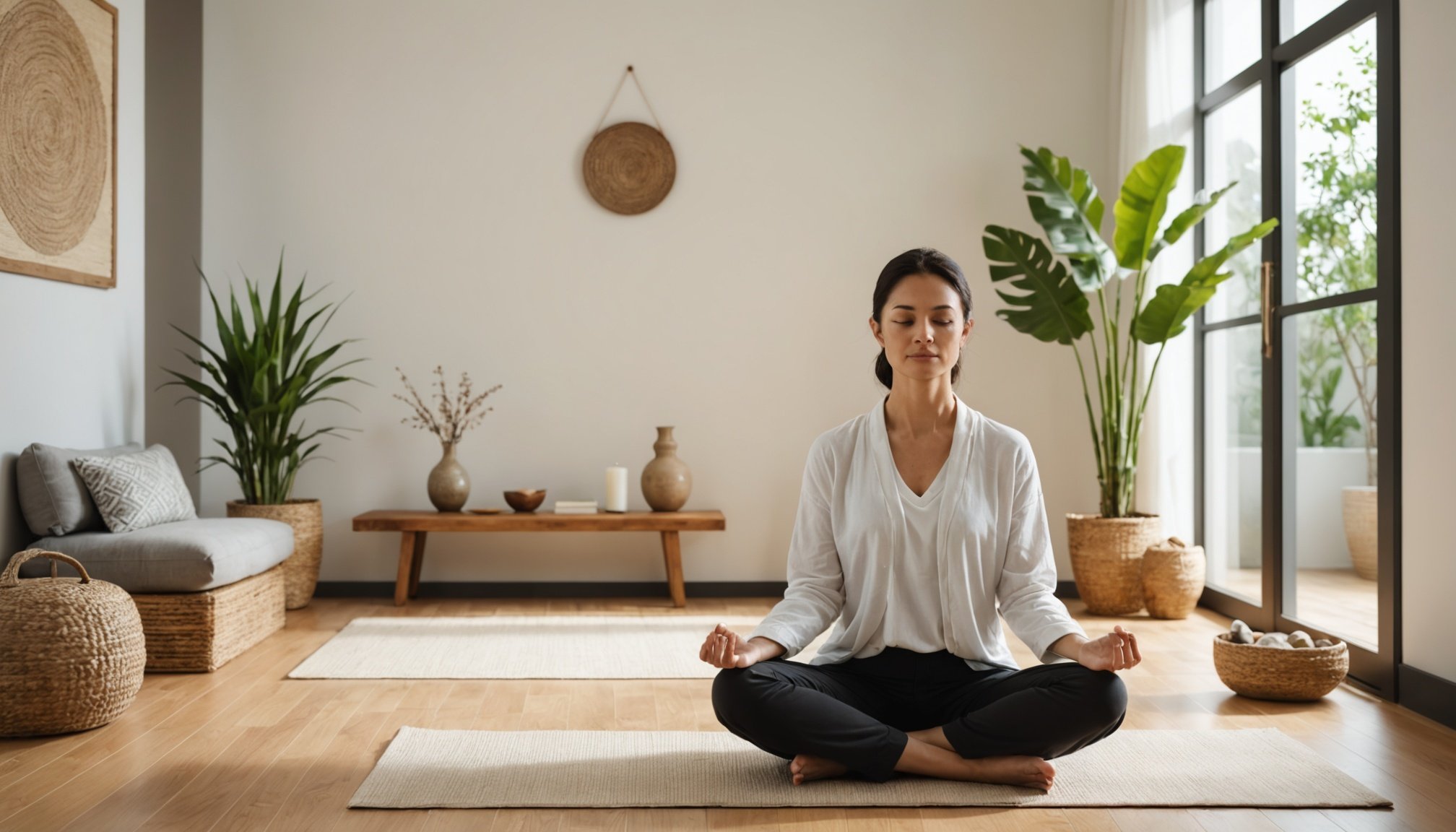Understanding Zen Spaces
Zen meditation spaces are vital for maintaining mental health, offering a respite from life’s stresses. They focus on creating a calm environment where a tranquil atmosphere promotes relaxation and introspection. The core principles of zen design emphasize simplicity, balance, and harmony, all of which contribute to creating this peaceful setting.
A tranquil atmosphere is achieved by integrating elements that evoke calmness, such as natural materials and soothing colors. These spaces can enhance mental health by providing a sanctuary where stress is minimized. In busy settings, it’s crucial to have an area dedicated to peace and reflection.
When integrating a calm environment into high-traffic areas, such as homes or offices, consider how these spaces can counterbalance the pace of daily life. Benefits include reduced anxiety and a better ability to concentrate. In high-traffic areas, zen spaces serve as vital oases, offering reprieve and promoting mental balance.
The art of creating zen meditation spaces is about making thoughtful choices that align with one’s personal needs and aesthetic preferences. By understanding the foundational elements of zen design, anyone can transform their environment into a haven of tranquility.
This might interest you : Experience cozy living and reduced energy costs with underfloor heating: the essential guide to sustainable comfort
Identifying High-Traffic Areas
A crucial first step in configuring a home layout to support tranquility is understanding which zones experience the most activity. These busy zones can be identified by observing the daily activity patterns in your living space. Perhaps it’s the kitchen where morning routines converge or the living room where the family gathers for evening relaxation—each home will have its unique touchpoints of high traffic.
The key is recognizing potential spaces for transformation that align with your lifestyle. For instance, a corner in the living room might be quieter in the mornings, making it an ideal spot to adapt into a zen meditation space. The level of noise and distractions plays a significant role in prioritizing these areas, as the quieter the space, the more effective it will be in cultivating calmness.
An efficient approach to space identification involves considering how furniture arrangement might impact foot traffic. Identifying high-traffic areas helps in converting overlooked corners into soothing retreats, thus ensuring that the balance and harmony at the core of zen design are upheld throughout the home. Embrace these opportunities for peace amidst the buzz of daily life.
Design Principles for a Zen Retreat
In designing a Zen retreat, embracing minimalist design is crucial. A simple yet sophisticated setup fosters an environment that encourages peace and mindfulness.
Choosing Appropriate Colours
The foundation of a serene space is the colour palette. Soothing colors, such as soft greens, pale blues, and warm neutrals, contribute significantly to the calming ambiance. These hues promote relaxation and can even lower stress levels, creating an inviting and restorative atmosphere.
Incorporating Natural Materials
Natural elements play a vital role in Zen design. Materials like bamboo, stone, and wood bring the earth’s tranquility indoors, creating a harmonious connection with nature. Elements such as water features or indoor plants can further enhance this connection, providing a sensory reminder of the natural world.
Layout Considerations
When considering your space’s layout, focus on light and openness. Ample natural light and unencumbered spaces help reduce clutter, allowing the mind to focus and rest. Proportions and symmetry are paramount in achieving a calming effect. They guide the eye naturally and foster a sense of balance and peace, transforming any area into a haven suitable for reflection and meditation.
Furniture Selection for Serenity
A major aspect of creating zen furniture is ensuring that each piece contributes to a calming decor and serves a purpose. The key is simplicity—choosing furniture that is comfortable yet straightforward helps to promote a serene environment. Avoid ornate designs that could overwhelm the senses and interfere with tranquility.
Functional pieces are a cornerstone of zen design. Consider multi-purpose furniture that can adapt to different needs. For instance, a futon that serves as a couch by day and a bed by night is both space-efficient and practical, aligning with the principle of minimalism.
Essential furniture pieces that enhance tranquility include low seating arrangements such as floor cushions or tatami mats. These enable a closer connection to the ground, reinforcing a sense of stability and peace. A small table might suffice for a tea ceremony or meditation, furthering the calming aesthetics of the space.
Remember to prioritize functionality and comfort when selecting furnishings for your zen space. This approach not only supports relaxation but also harmonizes with the overall design ethos of having clutter-free environments that cater to both rest and reflection.
Decor Ideas to Enhance Calmness
Elevating your zen space with thoughtful zen decor choices can significantly amplify its calming effect. By incorporating calming accessories and maintaining a peaceful aesthetic, you can create an environment that truly nurtures the soul.
Art and Wall Decor
Select art pieces that resonate serenity, such as landscapes or abstract designs with soothing colors. Wall decor should avoid clutter and revolve around themes that inspire peace and reflection.
Plants and Greenery
Plants and greenery are an essential aspect of fostering connection to nature within zen spaces. Integrating indoor plants not only purifies the air but also reminds us of nature’s tranquility. Choose low-maintenance varieties to keep the ambiance stress-free, such as peace lilies or ferns, adding lushness to the space.
Textiles and Soft Furnishings
Comfort is key when opting for textiles and soft furnishings. Opt for materials like cotton or linen that offer a cozy touch. Soft textiles such as cushions and throws can introduce warmth, further enhancing the space’s inviting nature. Keeping the color palette muted will maintain the desired peaceful aesthetic, allowing the area to serve as a true sanctuary for relaxation and meditation.
Mindfulness Techniques to Implement
Integrating mindfulness practices into your daily routine can significantly enhance the peace and balance of your zen space. Engaging in breathing exercises is one effective way to calm the mind and body. Deep, intentional breathing helps to lower stress and promotes focus, making it a simple yet powerful tool for tranquility.
Meditation is another core practice that can elevate your zen journey. Creating a specific time and place for meditation aids in developing a regular habit that supports mental clarity and emotional stability. Start with guided meditations if you’re new, gradually advancing to silent reflections as comfort grows.
Sound and smell can also play a transformative role in crafting a serene environment. Incorporate elements like soft music, chimes, or nature sounds to cultivate a calming auditory ambiance. Simultaneously, using scents like lavender or sandalwood with incense or essential oils can deepen a sense of peace and presence.
By incorporating these techniques, individuals can foster a profound connection between their minds and their physical surroundings, turning any space into a retreat for relaxation and introspection. These practices, adaptable to personal preferences, allow for a gentle immersion into mindfulness, thoughtfully supporting stress relief.
Personalizing Your Zen Space
Creating a personalized retreat is essential to making your zen space feel authentic and inviting. Tailor the environment with individual preferences to enhance its calming effect. This process begins with incorporating unique elements that resonate with your personal style and spiritual needs. Think of using objects that hold sentimental value or align with your aesthetic.
A helpful tool in this journey is a vision board. By gathering images and ideas that inspire you, you can visualize the atmosphere you wish to cultivate. It’s a creative way to refine your goals for the space, ensuring it caters to your desire for tranquility and reflection.
Introduce personal objects, such as family photos or travel mementoes, to enhance the overall calmness. These items not only imbue the area with warmth but also foster a sense of belonging and ease. They become visual anchors, connecting your space to positive emotions and memories.
Remember, personalizing a zen space is about seamlessly blending functionality with the deeper layers of who you are. Taking the time to create an environment that reflects your essence can profoundly boost your well-being and reinforce the sacredness of your personal retreat.
Maintenance and Adaptation
Maintaining a zen space requires not only its initial setup but also periodic evaluations to ensure it continues to meet evolving needs. Regularly assessing your environment helps identify areas where clutter may have accumulated or where certain elements no longer serve their purpose. Such assessments underscore the necessity of adaptability in preserving the serene atmosphere of your zen retreat.
To keep your area clutter-free, consider employing organisational tools like baskets or shelves that align with your individual preferences. These solutions support the zen principle of minimalism and ensure that essentials are accessible yet tuck away distractions. It’s crucial to periodically declutter, as this practice prevents overwhelm and maintains tranquility.
Embrace flexibility, allowing your zen space to evolve with life’s changes. This might mean adapting the space to new interests, such as incorporating a different mindfulness practice or rearranging furniture to suit new lifestyle habits. Staying attuned to your personal journey ensures the retreat remains personal and effective.
Remember, personalized retreats aren’t static. They grow as you do, reflecting both your current state and your aspirations. By consciously adapting your space, you continually reinforce its role as a refuge for peace and reflection.









